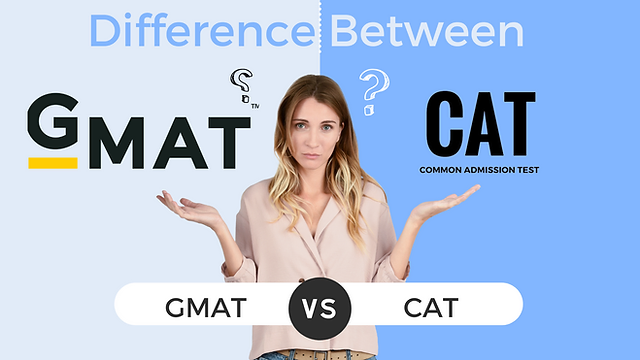GMAT vs CAT: Understanding the Differences and Choosing the Right Exam
Are you considering a career in business, but feeling overwhelmed by the multitude of entrance exams out there? Don’t worry – we’ve got your back! Today, we’re diving into the ultimate battle between two renowned exams: GMAT and CAT. These tests are like gladiators in the arena of business schools, each with its own strengths and weaknesses. But fear not, as we’ll guide you through understanding their differences and help you choose the right exam that will pave your way to success. So grab a seat, tighten your mental armor, and let’s embark on this thrilling journey towards acing your dream business school admission!
Introduction to GMAT and CAT exams:
The Graduate Management Admission Test (GMAT) and the Common Admission Test (CAT) are two of the most popular standardized exams used for admission into graduate business programs. These exams are designed to measure a candidate’s academic aptitude and potential for success in business school.
GMAT:
The GMAT is administered by the Graduate Management Admission Council (GMAC) and is accepted by over 7,000 graduate business programs worldwide. This exam consists of four sections: Analytical Writing Assessment, Integrated Reasoning, Quantitative Reasoning, and Verbal Reasoning. The total duration of the exam is three hours and seven minutes.
Also read : Masters in Management (MIM) in Canada: Top Universities, Eligibility, Fees, and Jobs
CAT:
On the other hand, CAT is conducted by the Indian Institutes of Management (IIMs) for admission into their postgraduate management programs in India. It is a computer-based exam and consists of three sections: Verbal Ability and Reading Comprehension, Data Interpretation and Logical Reasoning, and Quantitative Ability. The total duration of the exam is three hours.
Purpose and format of GMAT and CAT exams
The GMAT and CAT are two popular exams used for admission into top business schools and graduate programs. While the two exams may seem similar, there are key differences in their purpose and format that make them distinct from each other. In this section, we will dive deeper into the purpose and format of each exam to help you understand which one is the right choice for you.
Purpose of GMAT and CAT exams:
The Graduate Management Admission Test (GMAT) is primarily designed to assess a candidate’s readiness for graduate-level business studies. It tests a wide range of skills including analytical writing, integrated reasoning, quantitative reasoning, and verbal reasoning. The GMAT is accepted by over 7,000 programs at more than 2,300 universities around the world.
On the other hand, the Common Admission Test (CAT) is specifically designed for admission into Indian Institutes of Management (IIMs) and other premier management institutes in India. It primarily evaluates a candidate’s quantitative aptitude, data interpretation skills, verbal ability, and logical reasoning. The CAT score is also accepted by several non-IIM institutes across India.
Format of the Exams:
The GMAT consists of four sections – Analytical Writing Assessment (AWA), Integrated Reasoning (IR), Quantitative Reasoning (QR), and Verbal Reasoning (VR). The total duration of the exam is 3 hours and 30 minutes. AWA requires candidates to write an essay on a given topic within 30 minutes while IR has 12 questions to be completed in 30 minutes. QR and VR sections have 31 and 36 multiple-choice questions respectively to be completed in 62 and 65 minutes each.
The CAT, on the other hand, is a computer-based test with three sections – Verbal Ability and Reading Comprehension (VARC), Data Interpretation & Logical Reasoning (DILR), and Quantitative Ability (QA). The total duration of the exam is 3 hours, with each section having a time limit of one hour. VARC has 34 questions, DILR has 32 questions, and QA has 34 questions. Unlike GMAT, the CAT does not have an essay writing section.
Scoring System:
The GMAT is scored on a scale of 200-800 while the CAT is scored on a scale of 0-300. Both exams use computer-adaptive testing (CAT) format where the difficulty level of questions depends on the candidate’s ability. In GMAT, candidates will receive their scores immediately after completing the exam while CAT scores are released usually within two weeks after the exam.
Which Exam Should You Take?
If you are planning to pursue a graduate degree in business or management outside India, then GMAT is the right choice for you. However, if your goal is to get admission into IIMs or other top management institutes in India, then CAT would be a better option.
In conclusion, while both GMAT and CAT are entrance exams for management programs, they differ in their purpose and format. It is important to understand your goals and the requirements of the programs you are applying to before deciding which exam to take. Ultimately, the key to success in any exam is thorough preparation and practice.
Differences in content and structure
When it comes to choosing the right exam for your business school application, GMAT and CAT are two of the most popular options. Both exams are designed to assess students’ abilities in critical thinking, problem-solving, and decision-making skills. However, there are significant differences in content and structure between the two exams that you should consider before making a decision.
Content Differences
| Content Aspect | GMAT | CAT |
|---|---|---|
| Quantitative Section | Focus on algebra, geometry, and data analysis | Emphasis on arithmetic and data interpretation |
| Verbal Section | Includes sentence correction, reading comprehension, and critical reasoning | Strong focus on vocabulary and grammar through reading comprehension passages |
| Logical Reasoning | Has a dedicated Integrated Reasoning section | Does not have a specific section for logical reasoning |
Structure Differences
| Structural Aspect | GMAT | CAT |
|---|---|---|
| Test Duration | 3 hours 30 minutes | 3 hours |
| Question Format | Four options per question | Five options per question |
| Number of Questions | 90 | 100 |
| Scoring System | 200-800 | 0-300 |
In conclusion, GMAT and CAT are two different exams with their unique content and structure. It is essential to understand these differences before deciding which exam is more suitable for your business school application. Some factors to consider when making this decision include your strengths and weaknesses in different subjects, familiarity with computer-based testing, and the target schools’ preference for either exam. Ultimately, choosing the right exam will depend on your individual preferences and abilities.
How are the scores calculated?
GMAT and CAT are two popular entrance exams for graduate management programs in business schools. One of the most common questions that students ask when considering these exams is how the scores are calculated. Understanding the scoring process is essential as it can give you insights into which exam may be more suitable for your skills and abilities.
The GMAT exam has a total score range of 200 to 800, with increments of 10 points. This score is based on your performance in four sections: Analytical Writing Assessment (AWA), Integrated Reasoning (IR), Quantitative Reasoning (QR), and Verbal Reasoning (VR). Each section is scored separately, and then the scores from all four sections are combined to give you a total score.
The AWA section is scored on a scale of 0-6 by two independent readers who evaluate your ability to analyze an argument critically and effectively communicate your ideas in writing. The scores from both readers are averaged to give you a final AWA score.
The IR section has a score range of 1-8, with increments of one point. It measures your ability to evaluate information presented in different formats, including tables, graphs, and text passages. The questions in this section require critical thinking and data interpretation skills.
For the QR and VR sections, each question has a specific value depending on its difficulty level. These values range from one point for easy questions to six points for difficult ones. Your performance on these sections determines your scaled score, which ranges
Why choose one over the other?
The GMAT (Graduate Management Admission Test) and CAT (Common Admission Test) are two popular exams that are often taken by students aspiring to pursue a career in the field of management. Both exams are admission tests for prestigious business schools and have their own unique features. However, many students are often confused about which exam to choose between the two. In this section, we will discuss the differences between GMAT and CAT and help you understand why you should choose one over the other.
| Consideration | GMAT | CAT |
|---|---|---|
| International Recognition | Widely accepted globally, suitable for international business schools | Primarily accepted by Indian business schools, limited international recognition |
| Adaptive Nature | Adaptive format adjusts to test-taker’s skill level | Fixed question pattern for all candidates |
| Test Duration | 3 hours 30 minutes | 3 hours |
| Frequency of Testing | Year-round flexibility, multiple attempts allowed | Conducted once a year, limited attempts |
| Scoring Range | 200-800 score range | 0-300 percentile range |
| Cost | Expensive registration fees | Relatively lower registration fees |
| Suitability for Indian B-Schools | Accepted but less common in Indian B-schools | Widely accepted by Indian B-schools |
| Suitability for International Study | Well-suited for global MBA programs | Primarily focused on Indian management programs |
| Focus on Business Skills | Emphasis on analytical and critical thinking skills | Emphasis on speed, accuracy, and problem-solving skills |
| Admission Process | May be preferred for certain international programs | Preferred for Indian B-school admissions |
Pros and cons of GMAT
The GMAT (Graduate Management Admission Test) and CAT (Common Admission Test) are two of the most popular exams for students aspiring to pursue a management degree. While both exams serve the same purpose of evaluating a candidate’s aptitude for business studies, they have their own unique pros and cons. In this section, we will dive into the advantages and disadvantages of taking the GMAT.
| Pros | Cons |
|---|---|
| Widely Recognized | Expensive |
| Standardized Scoring | Time-Consuming |
| Comprehensive Evaluation | Limited Validity |
Pros and cons of CAT:
Like any other standardized test, the Common Admission Test (CAT) has its own set of advantages and disadvantages. In this section, we will discuss the pros and cons of taking the CAT exam to help you make a well-informed decision.
| Pros | Cons |
|---|---|
| Widely Accepted by Top B-Schools | Limited Attempts |
| Cost-Effective | Intense Competition |
| High Difficulty Level | Limited Scope Outside India |
Tips for preparing for each exam
Preparing for any exam can be a daunting task, but with the right approach and strategies, you can conquer it. The GMAT and CAT are both highly competitive exams that require thorough preparation to achieve desired scores. Here are some tips to help you prepare effectively for each exam:
- Familiarize Yourself with the Exam Structure: Before diving into your study materials, make sure you understand the structure of the exam you are preparing for. Both GMAT and CAT have different formats and question types, so it is crucial to know what to expect on test day.
- Create a Study Plan: A well-organized study plan can make all the difference in your preparation journey. Start by setting a realistic goal for yourself and then break down your study schedule accordingly. Allocate enough time for each section of the exam and incorporate breaks in between to avoid burnout.
- Practice, Practice, Practice: The key to success in any competitive exam is practice! This not only helps improve your speed and accuracy but also familiarizes you with the question patterns and format of the test. Make use of online resources such as mock tests or previous year’s papers to get a feel of the actual exam.
- Focus on Weak Areas: Identify your weak areas early on in your preparation journey and work on them consistently. Whether it’s quantitative aptitude or verbal reasoning, dedicate more time to these sections while studying.
- Utilize Study Materials: There is an abundance of study materials available for both GMAT and CAT, including books, online courses, and study guides. Make use of these resources to supplement your preparation and gain a better understanding of the concepts.
- Take Breaks: It’s crucial to take breaks in between your study sessions to avoid burnout. Use this time to relax, recharge, and rejuvenate your mind. Taking breaks also helps improve focus and retention of information.
- Join a Study Group: Joining a study group can be beneficial as you can discuss difficult concepts with others and learn from their perspectives. It also provides accountability and motivation to stay on track with your studies.
- Stay Healthy: Don’t neglect your physical health while preparing for exams. Make sure to eat well, exercise regularly, and get enough sleep each night to keep your mind and body functioning at its best.
- Revise Regularly: As you progress through your study materials, make sure to revise regularly to reinforce what you have learned. This will help you retain the information better.
- Stay Positive: Remember that preparation is key, but so is having a positive mindset. Believe in yourself and trust the hard work you have put in during your preparation journey.
Which exam is right for you?
Choosing between GMAT and CAT ultimately depends on your career goals and personal preferences. If you are aspiring to pursue management studies abroad or aiming for top business schools in India, then GMAT might be a better option. However, if you are looking to pursue management programs in India broadly, then CAT would be more suitable. It is essential to thoroughly research both exams’ format, difficulty levels and assess your strengths before making a decision.










